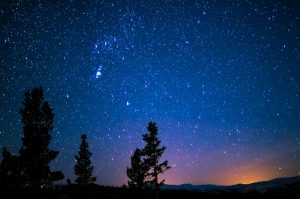 Author: Linda Sanford
Author: Linda Sanford
A sky brimming with stars should never be taken for granted! However, have you noticed the dimming of the stars? Depending on where we look up, we may notice that they seem dimmer than they used to be.
The evenings I spend in the quiet, absorbing nature and sounds as the sky goes from sunset to the shining stars, has become more challenging to share with others. It saddens me that what we’ve viewed for thousands of years may not be nearly as visible in the future.
According to research scientist Christopher Kyba: “… the introduction of artificial light probably represents the most drastic change human beings have made to their environment. Near cities, cloudy skies are now hundreds, or even thousands of times brighter than they were 200 years ago.”
The concept of how light pollution effects our own health, and the health of wildlife, as well as our entire ecosystem, is becoming increasingly important as we grow our awareness of lifestyle stewardship. Each step in our awareness and our actions makes a difference toward restoration and rehabilitation. And that, in turn, will enable us to continue enjoying the vibrancy of our night skies.
Earth’s daily rhythm of light and dark cycles govern life-sustaining behaviors for all living organisms including reproduction, nourishment, and sleep/rest. Throughout some parts of the world, as well as within the animal kingdom, it also includes protection from predators that hunt at night and that use the dark as cover.
My takeaway is this: Every day needs a night, and every organism needs the rhythm of light and dark cycles.
For the human body, the introduction of artificial light confuses it, and interrupts the body’s natural rhythms that guide day and night activities, and affects all physiological processes.
 So, how do we protect our environment’s night skies? How do we protect the light/dark rhythms that our bodies need, while living in homes where we must also incorporate light sources from something other than nature?
So, how do we protect our environment’s night skies? How do we protect the light/dark rhythms that our bodies need, while living in homes where we must also incorporate light sources from something other than nature?
Solutions that help me increase my well-being, and that contribute to my efforts to live in as healthy of a home as possible while helping to protect the nighttime environment, include:
As we spend time outside at night and as we revel in the night skies, the stars, and the planets that have been with us for thousands of years, let’s make sure we also recognize how our efforts to create healthy homes – with natural and artificial lighting – are important not only for our well-being, but for all organism that rely on earth’s daily rhythms of light and dark.
Want to know more about light pollution? Here’s a great article on how it can affect our sleep and moods.
I’d love to chat with you about how incorporating healthier inside and outside lighting at your home can increase your well-being as you create an overall healthier home and lifestyle.
Shenandoah Myrick
Sterling Real Estate Group
Managing Broker
2011 Young Street Suite 101
Bellingham, WA 98225
360-303-9083
Shenandoah4homes@gmail.com
GreenPod Development
Northwest Rain Solutions LLC
Whidbey Sun & Wind
Cottage Werks
Martha Rose Construction
Tiny Mountain Houses
Cascade Building Design